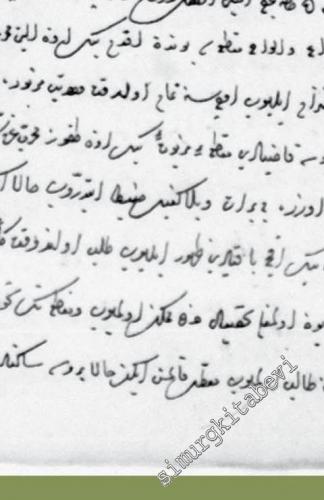#smrgKİTABEVİ The Celali Effect in the 17th Century - Ottoman Transformation -

The short and long run effects of these revolts are examined by focusing on the regions Northern and Central Anatolia, which were heavily affected by these revolts. The destructive effects of the Celali Revolts are dealt with between 1576 and 1643 owing to the availability of the case studies and Ottoman archival sources namely, the mukataa defters (tax-farming registers), iltizam talepnameleri (records of demands for tax-farms), and mühimme registers (records of imperial decrees). Moreover, the reports and letters of the French Embassy are also used since they provide important information that one can use to follow the destructive effects of the Celali Revolts..
TABLE OF CONTENTS
LIST OF TABLES
LIST OF ABBREVIATIONS
ACKOWLEDGEMENTS
CHAPTER I INTRODUCTION
The General Crisis of the 17th Century
The Ottoman Empire and the General Crisis
The Celali Revolts and the Celalis
The Celali Effect and the Sources
The Celali Effect
The Sources
Mukataa Registers
The Other Sources
Outline of the Study
CHAPTER II THE OTTOMAN DEMOGRAPHY IN THE CELALİ YEARS
The Celali Effect on Urban Population
An Urban "Population Pressure"
Inflation of Labour
The Reversal of "Labour Pressure"
Conclusion
The Celali Effect on Rural Population
The Sources and Studies
Filling the Celali Gap
The Question of Lost Peasants
The Celali Effect: An Assessment on Rural Population
Drastic Decline: "A Demographic Crisis"
The Question of the Lost Villages
Amasya
Tokat
The New Celali Settlements
Conclusion
CHAPTER III THE OTTOMAN ECONOMY AT THE TURN OF THE CENTURY AND THE CELALİ REVOLTS
The Celali Effect on The Rural Economy
Temporary Scarcity of Basic Foodstuff
Agricultural Production Crisis
Konya
Tokat
Conclusion
Silk and Mohair Industry in the Celali Years
Bursa Silk Industry
Ankara Mohair
Conclusion
The Adaptation of the Central Finance System
On the Transformation of Taxation
Shift from Tahrir Registers to Avarız
Mukataa Revenue Collection Problems
The Changing Conditions of Taxation
The Burden of the Celali Campaigns
Conclusion
CHAPTER IV THE GENERAL CONCLUSION
REFERENCES
INDEX
The short and long run effects of these revolts are examined by focusing on the regions Northern and Central Anatolia, which were heavily affected by these revolts. The destructive effects of the Celali Revolts are dealt with between 1576 and 1643 owing to the availability of the case studies and Ottoman archival sources namely, the mukataa defters (tax-farming registers), iltizam talepnameleri (records of demands for tax-farms), and mühimme registers (records of imperial decrees). Moreover, the reports and letters of the French Embassy are also used since they provide important information that one can use to follow the destructive effects of the Celali Revolts..
TABLE OF CONTENTS
LIST OF TABLES
LIST OF ABBREVIATIONS
ACKOWLEDGEMENTS
CHAPTER I INTRODUCTION
The General Crisis of the 17th Century
The Ottoman Empire and the General Crisis
The Celali Revolts and the Celalis
The Celali Effect and the Sources
The Celali Effect
The Sources
Mukataa Registers
The Other Sources
Outline of the Study
CHAPTER II THE OTTOMAN DEMOGRAPHY IN THE CELALİ YEARS
The Celali Effect on Urban Population
An Urban "Population Pressure"
Inflation of Labour
The Reversal of "Labour Pressure"
Conclusion
The Celali Effect on Rural Population
The Sources and Studies
Filling the Celali Gap
The Question of Lost Peasants
The Celali Effect: An Assessment on Rural Population
Drastic Decline: "A Demographic Crisis"
The Question of the Lost Villages
Amasya
Tokat
The New Celali Settlements
Conclusion
CHAPTER III THE OTTOMAN ECONOMY AT THE TURN OF THE CENTURY AND THE CELALİ REVOLTS
The Celali Effect on The Rural Economy
Temporary Scarcity of Basic Foodstuff
Agricultural Production Crisis
Konya
Tokat
Conclusion
Silk and Mohair Industry in the Celali Years
Bursa Silk Industry
Ankara Mohair
Conclusion
The Adaptation of the Central Finance System
On the Transformation of Taxation
Shift from Tahrir Registers to Avarız
Mukataa Revenue Collection Problems
The Changing Conditions of Taxation
The Burden of the Celali Campaigns
Conclusion
CHAPTER IV THE GENERAL CONCLUSION
REFERENCES
INDEX





















